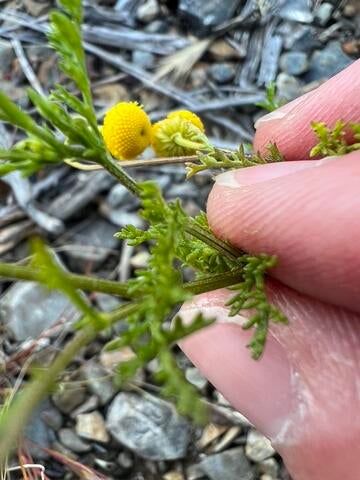Though prescribed burns reduce wildfire threats and even improve habitat for some animals, new research shows these fires also spread stinknet, an aptly named weed currently invading superblooms across the Southwestern U.S.
Stinknet, also called globe chamomile, is native to South Africa, but is commonly seen in photos of California’s colorful superblooms. “Not all flowering plants are indicative of a healthy ecosystem,” said Loralee Larios, UC Riverside assistant botany professor and study co-author. “This one isn’t.”
In addition to its unpleasant odor, each of its tiny yellow ball-shaped flowers can hold hundreds of seeds. While expanding across entire parks, it crowds out native plants on which endangered local animals rely.
The invader also reduces the overall health of the soil. In some cases, if an invasive plant changes the composition of the landscape enough, the soil can release stored carbon into the atmosphere, accelerating the negative effects of climate change.
For these reasons, the researchers looked more closely at how stinknet spreads. They found that after a prescribed burn, many unburned patches of stinknet remain in what is otherwise bare ground, free of competition from other plants. “In fact, patches of stinknet left over after a burn create focal points for more invasions,” Larios said.
This finding is detailed in the journal Restoration Ecology. To obtain it, the researchers observed plant behavior on a burned plot of land in Southern California’s Lake Perris State Park. Over two years, starting in 2020, they saw that the unburned stinknet patches had double the number of viable seeds, as compared to the areas that were completely burned and had no leftover stinknet.
It appears that singed patches create favorable microclimates for stinknet, creating soil temperature, light, and moisture conditions that help it spread.
Additionally, they found that adding native plant seeds back into the burned area did not significantly increase the presence of native species. “Stinknet likely releases chemicals through its roots that kill soil fungi essential for native plant growth,” said Stuart Schwab, a doctoral candidate in plant sciences at UCR and lead study author.
Because prescribed burns offer so many benefits for the landscape, including removing highly flammable invasive grasses, the researchers are not suggesting that land managers end the practice. Rather, they are calling for more targeted, secondary stinknet treatments after burns.
“Options could include pulling patches of remaining stinknet out of the ground by hand, or doing something called solarizing, where you put a dark tarp on an area to heat and kill any remaining seeds underneath,” Schwab said. “As a last resort they could use herbicides.”
Going forward, the research team would like to conduct similar studies to understand how fire impacts the spread of other invasive species.
In the meantime, hikers and nature lovers can do a lot to help stop stinknet spread. “Clean your boots if you go on hikes. That’s a major vector,” Schwab said. “The seeds are less than a millimeter wide. They’re tiny specks and easy to miss. Just brushing your shoes periodically can really minimize how far they travel.”
Finally, the researchers want non-scientists to feel empowered in the fight to minimize the impact of plants like stinknet on local ecosystems.
“The majority of invasive plants were originally discovered by non-scientists. UC Riverside undergraduates were the first to find stinknet,” Larios said. “Sharing with others through sites like iNaturalist is so important! Researchers can’t cover that much space by themselves.”




